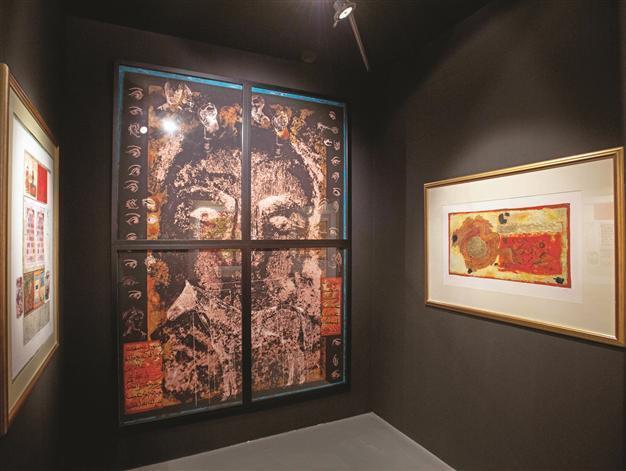Erol Akyavaş retrospective opens at Istanbul Modern
ISTANBUL- Hürriyet Daily News

Erol Akyavaş produced multidirectional work nourished by architecture and photography in his paintings. In his work from this period, he re-fictionalized historical imagery to make it relevant, this way moving the past into the present.
Istanbul Modern’s new exhibition “Erol Akyavaş – Retrospective” presents a comprehensive selection of the artist’s oeuvre spanning half a century from the 1950s to the late 1990s. The exhibition includes paintings by Akyavaş from different eras.The exhibition started yesterday will continue until Aug. 25, featuring a selection of 290 works. The exhibition brings together in great diversity the unique synthesis Akyavaş developed between the art and cultural worlds of the East and the West, his perspectival and architectural arrangements on the canvas in their transformation over time, his explorations of the subconscious that centered on the human figure, and the encounters he sought with the various cultures of the world.
The press conference held on the occasion of the opening of the exhibition was attended by Akyavaş’s wife, Ilona Akyavaş; the chair of Istanbul Modern’s board, Oya Eczacıbaşı; Finansbank executive vice president in charge of private banking Tunç Erdal; and Istanbul Modern chief curator and exhibition curator Levent Çalıkoğlu.
Eczacıbaşı said Akyavaş combined the mystical and sufistic aspect of Eastern art with Western art’s search for abstraction. “He also sought what lies beyond the mere appearance of reality. [He] explored Sufism with endless curiosity since his childhood with the ‘excitement of perhaps capturing something from within,’” she said. Akyavaş reflected his worldview, beliefs and aesthetics through his use of traditional symbols and images and, applying the delicate and detailed technique of master jewelers, created new forms that make historical references to cultural heritage, versatility, emotions, intuition and dreams.
According to Eczacıbaşı, Akyavaş produced multidirectional work nourished by architecture and photography, remaining distant to movements of the time, and subsequently he became inspired by religious and historical stories. In his work from this period, he re-fictionalized historical imagery to make it relevant, this way moving the past into the present.
Tradition and culture
Eczacıbaşı added that they were pleased to realize an exhibition that presented the exciting adventure of over 40 years of Akyavaş, who took on the challenge of possessing both Eastern and Western values, created a unique synthesis between his own tradition, Islamic art and culture, and Western art, culture and thought.
Çalıkoğlu said Akyavaş was an artist who lived with his dreams, fears, sexuality and faith and revealed that it was himself that was in actual fact at the center of his art.
Noting that despite all its visual, symbolic, divine and expressionist references, Çalıkoğlu said Akyavaş’s art represents the loves, experiences, joys, fears, weaknesses, affections and friendships their producer experienced throughout the period of time he continued to breathe.
“He visualizes the journey traversed to become human, the mysteries of the world that come before and after, and the labor we exert to breathe,” he added.
Çalıkoğlu added that Akyavaş composed a deep and diverse visual world that passed through a wealthy tradition of narrative and belief, and that at the center of this “search for the other world” which set him apart from his contemporaries, lay an existential love, an infinite curiosity toward the unknown and the desire to transform into art the divine which he felt he belonged to.
Life of Erol Akyavaş
Born in 1932 in Istanbul, Akyavaş studied painting at the Bedri Rahmi Eyüboğlu Studio at the Fine Arts Academy as a guest student, and took part in the exhibitions of this studio. He attended summer semester studies at the Accademia di Belle Arti di Firenze. He worked with André Lhote and Fernand Léger in Paris. In 1954 he went to the United States to study aesthetics and philosophy of art. From 1954 to 1960, he studied architecture with Mies van der Rohe at the Illinois Institute of Technology, in Chicago. He also worked as a photographer for a period of time; however, neither photography nor architecture provided Akyavaş with the artistic satisfaction he sought. He returned to painting and until his death in 1999, he produced countless images, and meanings with a style, which went beyond the artistic boundaries of painting.
His early work from the late 1950s, now part of the family and MoMA collections, are lyrical explorations where calligraphic script as a symbolic element is related to the tachiste understanding of color. In 1959, he began to use Eastern images in his paintings, whereas in the 1960s, abstract and figurative elements began to stand out. This interaction in his paintings brought together themes of social memory and cultural heritage. His paintings were also influenced by existential philosophy, and he uses religion and sexuality not as opposing elements, but as metaphors surrounding the individual.
From 1950 to 1960, he continued to search for his own unique language of narration within the diversity of the organic abstract. In addition to the small-scale post-cubist paintings he produced in an academic style in the early 1950s, he also sought a synthesis that would emerge from his interest in the Islamic tradition, Sufism and Eastern arts. Abstract and figurative elements were emphasized in his works from the 1960s. He uses architectural images throughout his career. For Akyavaş, architecture is more than a physical space; it is the representation of the vital and cultural production field of existence.
“The Glory of the Kings” (1959) was his first work to be included in the permanent collection of an international museum. In 1961, with this work, he became the first Turkish artist to be included in the collection of MoMA.
















